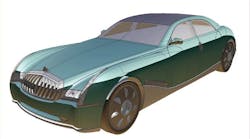Advanced Technology & Design Inc. will develop and supply a patternless casting design for engine components that will be installed in the world's most expensive production vehicle, the Natalia SLS 2. The $2-million vehicle will be produced by DiMora Motorcar, Palm Springs, CA, which is involved in a technical partnership with the Detroit specialty metalcaster.
DiMora Motorcar designs automobiles it says "exceed expectations for safety, performance, technology, ecology, beauty, comfort, and luxury." Its designs are presented online, so the public can learn and understand the process. Founder and CEO Alfred J. DiMora has been inducted into the Automotive Hall of Fame (1986), as has one of his designs, the Clenet. He also founded Starbridge Systems Inc., where he developed a FPGA supercomputer.
The Natalia SLS 2 will be a four-door sport/luxury sedan that DiMora Motorcar states will "feature dozens of innovations never seen before in any production automobile." Among these, it lists a 1,200-HP Volcano V16 engine, with variable-cylinder technology, a lightweight aluminum engine block, an advanced fuel system that needs no catalytic converter, and a chassis and body built with "advanced aerospace materials and construction techniques to give superior strength at a weight easily 1,500 lb less than luxury vehicles its same size."
Of the engine, DiMora Motorcars explains the "design, casting, and materials will set it apart from all prior engine technology." Advanced Technology & Design will design mold packages for the Natalia's engine, using rapid casting technology. In just over 10 years, ATD has evolved from a pattern shop into a casting-technology specialist contracted by engine developers and race teams to produce complex and critical components for their power trains.
Jeffrey McDaniel, an engineering and project manager with The ExOne Co.'s Prometal subsidiary confirms ATD is using its Rapid Casting Technology (RCT) process, and that the two firms have cooperated on several projects. Prometal's RCT makes it possible for foundries to produce sand molds and cores directly from CAD files. ProMetal also designs, builds, and operates molding and coremaking machines, and its systems are in operation in North America, Europe, and Asia by automotive, aerospace, heavy-industry and defense suppliers.
According to McDaniel, RCT is a rapid-prototyping process that uses printing technology to build a shape, such as a mold or a core, from a CAD file by interpreting “slices” of the structure electronically. It then builds the shape by “printing” the slices, one after another.
As McDaniel explained to FM&T, “The base materials that we use match what foundries use exactly. We use silica sand and furan binding systems.” The significant difference is that no tooling is required to form the mold or core.
Prometal emphasizes that the RCT process can be used to produce prototype castings economically and to validate mold designs. In certain applications, it could be used to eliminate coreboxes or to produce especially intricate cores. The molds or cores produced by RCT can be used for casting aluminum, copper alloys, ductile iron, gray iron, and steel. Magnesium also maybe cast by mixing an inhibitor into the sand.
Car-designer Alfred J. DiMora emphasizes the importance of using the most advanced casting methods for technically advanced engines. "The extreme complexity of the 16-cylinder DiMora Volcano engine requires the flexibility and precision that only RCT can provide. ATD continues to push the state of the art in patternless casting, and has utilized it for the development of extremely complicated prototypes. Now we are taking the next step and using their expertise to build engine castings for our production automobile," he states.
According to ATD, rapid casting technology offers flexibility for producing complex, finely detailed, patternless castings, and yet reduces production costs and time to market. ATD president Clifford Sands adds that "By removing the constraints of hard tooling, RCT allows extreme engine design to become a reality. At 14 liters displacement and producing 1,200 horsepower, the proprietary DiMora Volcano V16 is an extreme engine design. We take DiMora's CAD data file and design the sand mold assembly which will be used to create this cutting-edge engine."










